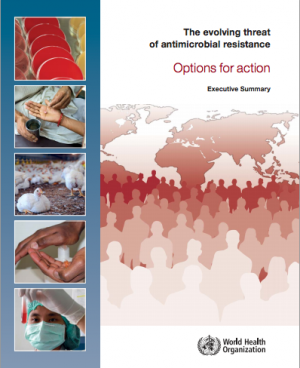Antimicrobial Resistance: Difference between revisions
Kim Jackson (talk | contribs) No edit summary |
Kim Jackson (talk | contribs) (Added links to PP pages) |
||
| Line 1: | Line 1: | ||
== Introduction == | == Introduction == | ||
[[Image:Antimicrobial Resistance.png|thumb|right|"The evolving threat of antimicrobial resistance - Options for action". Policy document from WHO]]Antimicrobial resistance (AMR) is not a recent phenomenon, but it is a critical health issue today. Over several decades, to varying degrees, bacteria causing common infections have developed resistance to each new antibiotic, and AMR has evolved to become a worldwide health threat. With a dearth of new antibiotics coming to market, the need for action to avert a developing global crisis in health care is increasingly urgent. | |||
In addition to a substantial financial burden that national health-care budgets can ill afford, AMR has economic consequences far beyond the health sector, such as damaging repercussions on international travel and trade resulting from the cross-border spread of resistant infections. The cost of not acting against AMR needs to be considered when deciding resource allocation and assessing interventions. | |||
Some of the most common bacterial infections resistant to antibiotics are: | |||
* [[Methicillin-Resistant Staphylococcus Aureus|Methicillin-Resistant Staphylococcus Aureus (MRSA)]] | |||
* [[Pneumonia]] | |||
* [[Tuberculosis]] | |||
* Gonorrhoea | |||
* Blood stream infections | |||
* Escherichia coli | |||
== Resources == | == Resources == | ||
[http://www.who.int/patientsafety/implementation/amr/publication/en/index.html The evolving threat of antimicrobial resistance - Options for action<ref>The evolving threat of antimicrobial resistance - Options for action. WHO. 2012</ref>] describes examples of policy activities that have addressed antimicrobial resistance in different parts of the world, with the aim of raising awareness and in particular to stimulate further co-ordinated efforts. | [http://www.who.int/patientsafety/implementation/amr/publication/en/index.html The evolving threat of antimicrobial resistance - Options for action<ref>The evolving threat of antimicrobial resistance - Options for action. WHO. 2012</ref>][[Antimicrobial Resistance|<span class="mw-reflink-text">[1]</span>]] describes examples of policy activities that have addressed antimicrobial resistance in different parts of the world, with the aim of raising awareness and in particular to stimulate further co-ordinated efforts. | ||
== References == | == References == | ||
Revision as of 14:19, 12 January 2020
Introduction[edit | edit source]
Antimicrobial resistance (AMR) is not a recent phenomenon, but it is a critical health issue today. Over several decades, to varying degrees, bacteria causing common infections have developed resistance to each new antibiotic, and AMR has evolved to become a worldwide health threat. With a dearth of new antibiotics coming to market, the need for action to avert a developing global crisis in health care is increasingly urgent.
In addition to a substantial financial burden that national health-care budgets can ill afford, AMR has economic consequences far beyond the health sector, such as damaging repercussions on international travel and trade resulting from the cross-border spread of resistant infections. The cost of not acting against AMR needs to be considered when deciding resource allocation and assessing interventions.
Some of the most common bacterial infections resistant to antibiotics are:
- Methicillin-Resistant Staphylococcus Aureus (MRSA)
- Pneumonia
- Tuberculosis
- Gonorrhoea
- Blood stream infections
- Escherichia coli
Resources[edit | edit source]
The evolving threat of antimicrobial resistance - Options for action[1][1] describes examples of policy activities that have addressed antimicrobial resistance in different parts of the world, with the aim of raising awareness and in particular to stimulate further co-ordinated efforts.
References[edit | edit source]
- ↑ The evolving threat of antimicrobial resistance - Options for action. WHO. 2012







